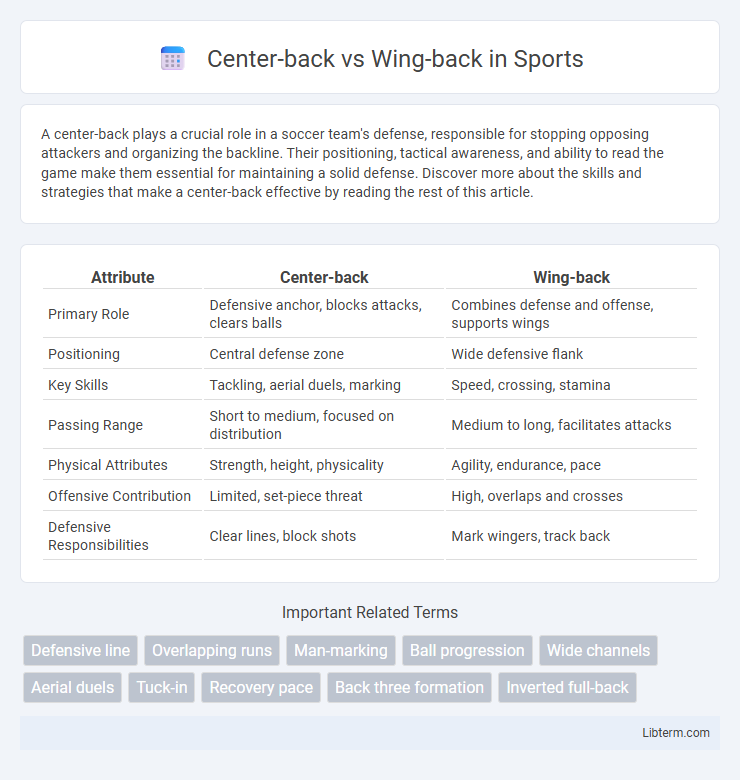A center-back plays a crucial role in a soccer team's defense, responsible for stopping opposing attackers and organizing the backline. Their positioning, tactical awareness, and ability to read the game make them essential for maintaining a solid defense. Discover more about the skills and strategies that make a center-back effective by reading the rest of this article.
Table of Comparison
| Attribute | Center-back | Wing-back |
|---|---|---|
| Primary Role | Defensive anchor, blocks attacks, clears balls | Combines defense and offense, supports wings |
| Positioning | Central defense zone | Wide defensive flank |
| Key Skills | Tackling, aerial duels, marking | Speed, crossing, stamina |
| Passing Range | Short to medium, focused on distribution | Medium to long, facilitates attacks |
| Physical Attributes | Strength, height, physicality | Agility, endurance, pace |
| Offensive Contribution | Limited, set-piece threat | High, overlaps and crosses |
| Defensive Responsibilities | Clear lines, block shots | Mark wingers, track back |
Understanding Center-Back and Wing-Back Roles
Center-backs primarily serve as the defensive backbone, tasked with marking strikers, intercepting passes, and organizing the defensive line. Wing-backs combine defensive duties with offensive support, often advancing along the flanks to deliver crosses and create width in attack. Understanding these distinct roles highlights the center-back's focus on central defense and the wing-back's hybrid function between defense and midfield.
Core Responsibilities on the Pitch
Center-backs primarily anchor the defense by marking strikers, intercepting passes, and winning aerial duels to prevent goal-scoring opportunities. Wing-backs operate along the flanks, balancing defensive duties like tracking wingers with offensive contributions such as delivering crosses and supporting wide attacks. Both roles demand strong tactical awareness, but center-backs focus on central solidity while wing-backs provide width and transitional play.
Positional Differences and Field Coverage
Center-backs primarily occupy central defensive positions, focusing on marking strikers, intercepting passes, and clearing aerial threats in the penalty area. Wing-backs operate along the flanks, combining defensive duties with offensive support by covering wide areas, providing crosses, and tracking wingers. Their positional responsibilities result in center-backs covering narrower, central zones, while wing-backs cover broader, lateral areas of the field.
Defensive Techniques and Tactics
Center-backs excel in aerial duels, tight marking, and positioning to intercept central attacks, using zonal or man-to-man defensive tactics to maintain a solid defensive line. Wing-backs combine defensive duties with width coverage, employing tactics like tracking runs, blocking crosses, and supporting full-backs to neutralize wide threats effectively. Both roles demand strong tackling, anticipation, and communication but differ in spatial responsibilities, with center-backs focusing on central defense and wing-backs covering flanks.
Attacking Contributions and Overlapping Runs
Center-backs primarily focus on defensive solidity, rarely venturing forward, whereas wing-backs play a crucial role in attacking contributions by providing width and delivering crosses from advanced wide positions. Overlapping runs by wing-backs stretch opposition defenses, create overloads on the flanks, and facilitate combination plays with wingers or midfielders, enhancing offensive dynamics. The tactical deployment of wing-backs in formations like 3-5-2 or 5-3-2 significantly increases attacking options compared to the largely defensive, centrally positioned center-backs.
Key Skills Required for Each Position
Center-backs require exceptional tactical awareness, strong aerial ability, and precise tackling to effectively neutralize opposition attacks and dominate central defensive zones. Wing-backs need high stamina, speed, and excellent crossing skills to support both defense and wide offensive plays while maintaining positional discipline along the flanks. Mastering ball control, decision-making under pressure, and communication are crucial for both roles to ensure cohesive team defense and transition play.
Formations Favoring Center-Backs vs. Wing-Backs
Formations favoring center-backs typically include 4-4-2 and 3-5-2, where the emphasis lies on a strong defensive line with two or three central defenders providing stability and control in the backline. Wing-backs thrive in formations such as 3-4-3 and 5-3-2, which rely on their ability to cover wide areas both defensively and offensively, often demanding high stamina and versatility. The choice between center-backs and wing-backs significantly impacts team balance, with center-backs prioritizing structural solidity and wing-backs enhancing width and attacking support.
Impact on Team Strategy and Style of Play
Center-backs anchor the defensive line, providing stability and ensuring tight marking of opposition forwards, which allows teams to maintain a solid, compact defensive shape. Wing-backs offer width and attacking support, transforming formations into more flexible, dynamic systems that balance defense with offensive width and crossing opportunities. Integrating wing-backs often encourages high pressing and overlapping runs, while relying on center-backs prioritizes a more conservative, depth-focused defensive strategy.
Notable Players: Center-Backs vs. Wing-Backs
Notable center-backs like Virgil van Dijk and Sergio Ramos excel in strong defensive positioning, aerial duels, and leadership at the back, anchoring their teams with tactical awareness and resilience. Prominent wing-backs such as Trent Alexander-Arnold and Jordi Alba combine defensive duties with offensive thrusts, delivering precise crosses and dynamic runs that enhance width and attacking options. The distinction in roles is highlighted by center-backs' core defensive responsibilities versus wing-backs' hybrid function bridging defense and attack, shaping team formations and strategies.
Choosing the Right Position: Factors to Consider
Choosing the right position between center-back and wing-back depends on a player's physical attributes, tactical awareness, and stamina levels; center-backs require strong aerial ability and positional discipline, while wing-backs must excel in pace, crossing, and defensive versatility. Team formation and playing style significantly influence this choice, with wing-backs fitting systems that emphasize width and overlapping runs, whereas center-backs are critical in formations prioritizing defensive solidity. Coaches should assess the player's technical skills, such as ball control and passing accuracy, alongside their ability to adapt to either a central or wide defensive role to optimize team performance.
Center-back Infographic

 libterm.com
libterm.com